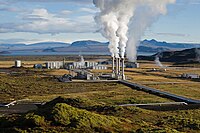
Photo from wikipedia
Abstract We extend to intermediate and deep earthquakes the slowness parameter Θ originally introduced by Newman and Okal (1998). Because of the increasing time lag with depth between the phases… Click to show full abstract
Abstract We extend to intermediate and deep earthquakes the slowness parameter Θ originally introduced by Newman and Okal (1998). Because of the increasing time lag with depth between the phases P, pP and sP, and of variations in anelastic attenuation parameters t ∗ , we define four depth bins featuring slightly different algorithms for the computation of Θ . We apply this methodology to a global dataset of 598 intermediate and deep earthquakes with moments greater than 10 25 dyn∗cm. We find a slight increase with depth in average values of Θ (from −4.81 between 80 and 135 km to −4.48 between 450 and 700 km), which however all have intersecting one- σ bands. With widths ranging from 0.26 to 0.31 logarithmic units, these are narrower than their counterpart for a reference dataset of 146 shallow earthquakes ( σ = 0.55 ). Similarly, we find no correlation between values of Θ and focal geometry. These results point to stress conditions within the seismogenic zones inside the Wadati-Benioff slabs more homogeneous than those prevailing at the shallow contacts between tectonic plates.
Journal Title: Physics of the Earth and Planetary Interiors
Year Published: 2018
Link to full text (if available)
Share on Social Media: Sign Up to like & get
recommendations!